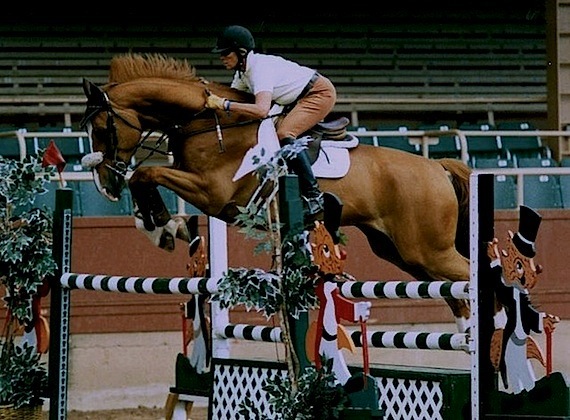Research Report: The futility of the whip, show-jumper style
- December 1, 2025
- ⎯ Fran Jurga
[Note: This article was originally published on July 28, 2013.] In 2011, Professor Paul McGreevy and his research group at the University of Sydney (Australia) won the Eureka Prize for Scientific Research that Contributes to Animal Protection for their study on the futility of whipping racehorses to get them to run faster. The study is credited with influencing some countries to modify their rules regarding whip use on horses during a race.
British follow-up on jumpers
Catherine Watkins and Darcy Murphy of Hartpury College in Gloucester, England have published the results of a new study in the Proceedings of the 2013 International Society for Equitation Science (ISES) Conference. They applied McGreevy’s logic to show jumpers: If a rider carries or uses the whip, is s/he more likely to achieve a clear round?

The researchers observed 229 non-elite and 229 elite show jumpers at affiliated British show jumping competitions. They recorded whip carriage, use and rein release. (Rein release was defined as the action by the rider to put the reins into one hand when applying the whip.) Non-elite riders were found more likely (69%) to carry one than elite riders (62%). Faults were reportedly 1.3 times more likely to occur for those riders who carried one.
The likelihood of achieving a clear round decreased for riders who used the whip. Meanwhile, riders who carried but did not use one fared better. Elite riders who carried the whip but did not use it fared the best.
‘Active’ vs. restricted whip use
In addition to calculating the likelihood of achieving faults or clear rounds, the researchers compared active use of the whip with current British Show Jumping rules. These state that: misuse or excessive use will not be tolerated; the whip should not be used more than three times after entering the arena; the whip cannot be used before commencement of the course; and the whip is only to be used if the rider removes a hand from the reins.
In spite of these rules, Watkins and Murphy observed what they termed “a fair amount of misuse or excessive use of the whip in the arena.” The study found a total of 38 cases where one was used either as a punishment tool or was not presented at the fence. Of all the show jumping riders observed, none were reprimanded for misuse of the whip or rule infractions.
‘Non-elite’ rider use of whip more likely
Of the 458 rounds observed, 65.5% of riders carried a whip and 20.7% of those who carried one used it. Non-elite riders were more than twice as likely to use the whip. It was speculated that knowledge and experience level reduced the likelihood of the whip being used. An alternative possibility is that elite riders are on higher quality, more athletic horses that simply don’t have as much “need” for such an aid.
This information may be of value to both show jumping organizations reviewing position statements on whip use and equestrians competing in shows. With an increase in public awareness of welfare in equestrian sport, discussion of the rules governing whip use is gaining momentum. As evidence emerges from other disciplines, the ISES states there is clearly a need for continuing reviews of their use.
Not reliable enough
At the same conference, McGreevy expanded his study of racehorse whipping with a research report, “The force of whip impacts delivered by jockeys using ‘forehand and backhand strikes.’ It documented that whip action (forehand versus backhand) does not influence force on impact when using the non-dominant hand. However, when using the dominant hand, jockeys struck with more force in the backhand.
This result challenges the current focus on welfare concerns around forehand whip strikes. The Proceedings of the Conference concludes that rules of racing that limit only forehand whip use cannot be relied upon to safeguard horse welfare.
About ISES
The International Society for Equitation Science (ISES) is a not-for-profit organization “that aims to facilitate research into the training of horses to enhance horse welfare” and improve the horse-rider relationship. Visit the ISES web site at www.equitationscience.com.
To learn more:
Futility of Whipping Racehorses Wins Research Prize for University of Sydney’s McGreevy
Evaluation of whip use and prevalence in elite and non-elite show jumpers by Catherine Watkins and Darcy Murphy in the Proceedings of the 9th International Equitation Science Conference.
To read about the FEI’s 2025 efforts to safeguard jumper welfare, click here.





